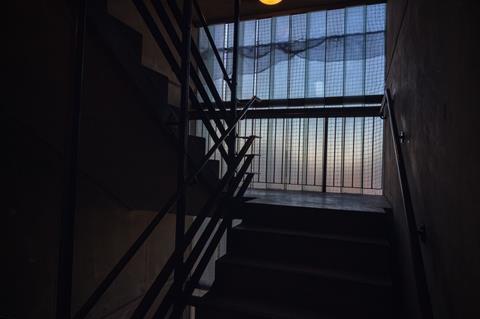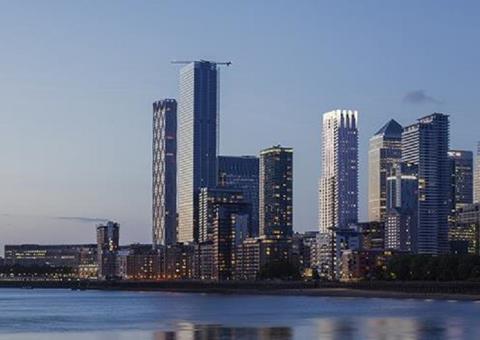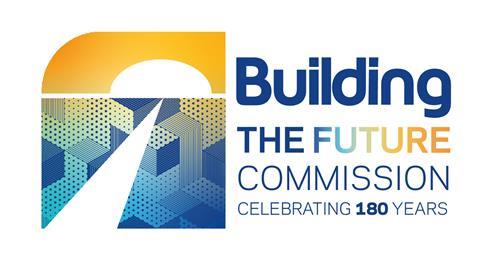Under pressure from fire chiefs, the RIBA and campaigners, Michael Gove announced plans before Christmas for mandatory second staircases in towers over 30m. But what impact is this likely to have?

“If you had the choice, would you choose to live at the top of a 30m block with just one staircase?”
This question, posed by Suzannah Nichol, chief executive of Build UK to Building, cuts to the heart of the reasoning behind the government’s latest building safety announcement.
Nearly six years after the Grenfell fire, the public understandably lacks confidence in the industry’s ability to make tall buildings safe. New legislation has been designed to ensure that such a disaster never happens again, but is it enough? There is a prevailing view that people living in tower blocks will continue to feel unsafe unless multiple means of escape are provided in new developments.
On 23 December, as the country wound down for Christmas, the Department for Levelling Up, Housing and Communities (DLUHC) pushed out a short consultation paper proposing a number of amendments to Approved Document B of the Building Safety Regulations. The most eye-catching was a blanket ban on single staircases in new blocks above 30m in height (equivalent to around 10 storeys in a standard residential building).
The announcement has certainly caught a lot of industry experts off guard. After all, banning buildings of a certain height with just a single staircase was not recommended in Dame Judith Hackitt’s review of building regulations in 2018. So when did the idea find favour with government ministers?

Those following the building safety debate closely will have noticed the government’s letter to building control bodies last August warning of “the need for robust, evidence-based design by suitably competent professionals” in situations such as “tall residential buildings proposed with a single stair”. However, this guidance stopped short of an outright ban.
One could have been forgiven for thinking the government was content to take a less prescriptive and a more evidence-based approach, given all the other requirements coming down the line through regulations under the Building Safety Act.
However, with the National Fire Chiefs Council (NFCC) calling for a ban on single-staircase towers (albeit over 18m in height) Grenfell campaigners’ calling for second staircases and public opposition forcing the withdrawal of planning applications for single staircase developments perhaps it is not surprising that the government now wants to go down this route. “A minimum of two protected staircases provides additional escape routes for residents and additional access routes for firefighters,” the NFCC has said.
The case for second staircases in new blocks
The National Fire Chiefs Council argues second staircases should be mandatory in blocks above 18m in height.
In a fire, it says, “a correctly designed second staircase removes the risk of a single point of failure, buying critical time for firefighting activities, and providing residents with multiple escape routes.”
Fire chiefs point to London Fire Brigade figures which show that nearly 8,500 residents chose to evacuate buildings rather than stay put between 1 April 2019 and 31 March 2022.
The Department for Levelling Up, Housing & Communities said in its consultation paper in December: “The provisions of a second staircase can provide some benefits for very tall residential buildings, such as added resilience for extreme events and reduced conflicts between emergency responders entering a building and those trying to escape, reducing the risk of the smoke ingress into an “escape” stairwell.”
It said a second staircase would also provide a second means of escape if one route is filled with smoke.
So, with the publication of details of a proposed ban and with a little under two months left of the consultation period, how is the construction and housebuilding industry responding?
What challenges are firms likely to face in putting in second staircases? And are there likely to be any negative, unintended consequences of a new rule which, on the face of it, seems like common sense?
Calls for clarity
The first thing to mention is that confusion over the approach to take has been ongoing for a while. The government letter last August warned building control bodies against relying on the current Approved Document B to approve single staircases in tall buildings and said specific evidence to justify such a decision should be sought, such as a “detailed fire engineering analysis”.
The Royal Institute of British Architects (RIBA) has welcomed the consultation paper. Last summer it criticised the government on this issue for a lack of clarity.
Simon Allford, president of RIBA, said: “We urgently require building regulations and guidance to set out a clearly defined height threshold at which two or more staircases are necessary… until we have that definition, we cannot move forward with certainty.”
Would the government’s proposed 30m ban clarify things?

Simon Bayliss, managing partner at HTA Design, said it would be useful for the government to demonstrate with evidence to what extent buildings of different heights are safer with a second staircase. After all, while the 30m rule would be followed by industry if it were implemented, the evidence base would surely inform firms’ decisions about buildings under the threshold also.
“Why are we pursuing this route? What has led Michael Gove to believe it [that single staircases should be banned], is it because the fire chiefs have recommended it? But the fire chiefs have recommended over 18m, so even now there is not a consensus,” says Bayliss.
Neil Jefferson, managing director of the Home Builders Federation, agrees. He says: “We have a situation where the NFCC are stipulating an 18m threshold and DLUHC a 30m one. It is causing nervousness both in the public and private sectors as to which guidance to follow for schemes moving forward.”
Jefferson says HBF members generally support the second staircase principle but need clarity on which guidance to follow, along with transitional arrangements to ensure housing delivery is not affected.
Bayliss says the proposed 30m limit would be a “sensible cut-off” as a lower limit of 18m would have a much more dramatic impact, affecting “almost every [tower block] project in London”.
The consultation
Andrew Mellor, partner at architect PRP and a Building the Future commissioner, questions the lack of detail in the government’s short consultation paper.
Mellor recently wrote: “The consultation does not provide a full understanding as to whether the second staircase will need to be an escape staircase, a firefighting staircase or an accommodation staircase – or perhaps all of these.” He says the industry needs sight of the new guidance as soon as possible before the introduction of the changes.
>> Click here for more about the Building the Future Commission
The short consultation period, which is running for 12 weeks but was effectively shorter as it encompassed the Christmas break, also means the industry does not have long to submit its own evidence. And the lack of evidence does nothing to placate those who feel the 30m rule could have unintended consequences for fire safety.
Staircases alongside other safety measures
While nobody would argue that putting in a second staircase would make a building more unsafe, there are concerns that the requirement could prove a distraction from looking at fire safety in the round. Simon Tolson, senior partner at Fenwick Elliott and a Building the Future commissioner, says the 30m rule seems “kneejerk”.

He adds: “The design of passive fire protection measures, such as travel distances, compartmentation, fire stopping, and number of stairs should always be balanced with active systems such as smoke ventilation, automatic detection, alarms, sprinklers, fire curtains and evacuation policy.”
He adds that he suspects there will be “many single-storey tall buildings that are ultimately safer than mandated two-staircase buildings.”
Adam Eaton, director of fire safety at Hydrock, points out that the various provisions in the Building Safety Act, with its gateway points, duty holder requirements and the golden thread of information, should give confidence that buildings are more safe than before.
He says the requirement for an evacuation alert system in buildings over 18m high, sprinklers over 11m and the tightening up of the use of combustible materials in external walls all need to be considered when looking at fire safety.
Eaton says: “If all these factors – the evacuation alert system, the sprinkler systems, the non-combustible external walls – are designed correctly and the single staircase does not connect with any risk areas, then in many cases the single staircase would still be considered safe in my mind.”
Given the need to get all of these factors right, Eaton is concerned that a second staircase may be seen as a panacea that indirectly leads to other things being neglected, particularly with the ongoing maintenance of buildings.
If all these factors – the evacuation alert system, the sprinkler systems, the non-combustible external walls – are designed correctly and the single staircase does not connect with any risk areas, then in many cases the single staircase would still be considered safe in my mind
Adam Eaton, Hydrock
“The danger is somebody could think it doesn’t matter if, for instance, there are failings with fire doors because there is a second staircase. But you may only have a single fire door in the centre of the corridor and, if there is something wrong with it, you could get smoke spread in two directions towards both staircases.”
He warns there is a danger that people could become “less attentive to the detail within the building” and that a blanket 30m rule does not consider the nuances of building safety design. Eaton says the 30m rule could also cause anxiety to residents who live in current tall blocks that won’t be affected by the new rule.
Practicalities of second staircases
Regardless of where you stand on the debate, if the government amends building regulations as proposed, then the industry would have no choice but to crack on and ensure second staircases are included in buildings over 30m in height, even if firms opt for single staircases in buildings between 18m and 30m in defiance of the fire chiefs. So what impact will this have?
In the short term, schemes with 30m blocks that have had planning but have yet to start on site would have to be revised with fresh planning consents needed.
Bayliss says: “We have a project at the moment with around 20 buildings in total, three of which are over 30 storeys. We will have to revise the planning application and this will delay the project for about a year, so that’s a dramatic impact.”
Redrawing and submitting a revised planning application would be timely and use resources, but this cost would only be part of much bigger expenditure facing developers switching from single-staircase to two-staircase development.
Incorporating a full second staircase reduces the area of the building that can be sold or rented out, reducing the value of the development if all else is equal. Then there is the cost of creating a larger building to accommodate the additional stair core, and potentially extra building on top of that to compensate for the loss of saleable area.
James Clark, partner at Core Five, (see below) says the value lost by reducing saleable area to incorporate a second staircase outweighs the cost of adding extra area to compensate by around four times as much. Therefore, one consequence of the 30m rule could see developers opting for bulkier blocks than they might have gone with had the rule not been introduced.
Why the 30m rule is likely to result in bulkier (and possibly taller) tower blocks
What would be the financial impact of developing a two-staircase block as opposed to one with a single staircase?
James Clark, at Core Five, takes the example of a typical high-rise development with a floorplate of 8,500ft2 and assumes a sales value of £2,000 per ft2.
He says an additional staircase would take up around 215ft2 per storey. If no area is added to the building, there will therefore be a loss of value of around £425,000 per storey, assuming that where a second staircase is introduced a corresponding amount of saleable area is also lost.
However if additional saleable area is added to the building to compensate by making the tower bulkier, this would cost around £100,000 per storey. Therefore it makes sense to make the floor plate bigger to recoup the £425,000 lost per storey through reduced saleable space.
He says: “It is reasonably safe to say that the value multiplier is roughly four times the cost of creating the area – which is why it makes sense to do it”.
Clark says another option is to add on storeys to the building rather than increasing its footprint but the value multiplier will be less as the stair cores will eat into the amount of saleable area.
However if the floor plate becomes bigger, architects may want to make the building taller anyway to achieve the “slenderness” ratio they desire.
Bayliss agrees that developers will be looking to create more saleable area. He suggests that, while the rules may favour the development of blocks below the 30m threshold – to avoid the second staircase issue – they are also likely to lead to a greater proportion of blocks significantly above 30m.
“Once you get above the height of 30m, you’d be pushing to go as high as possible to help pay for it,” he says.
Bayliss also says towers will have bigger footprints to accommodate the extra stair cores, and this would lead to more height being required to “get to an ideal slenderness ratio… it will drive architectural form”.
Another possibility of course is that the drop in saleable area in buildings could cause developers to ensure viability in other ways, such as seeking to cut back on the proportion of affordable housing in developments.
This is recognised in the government consultation paper, which says the viability impact is “likely to reduce the amount of affordable housing that can be provided by developers”.
Paul Hackett, chief executive of 77,000-home housing association Southern Housing and chair of the G15 group of London housing associations, is well aware of these concerns. He says it is important buildings have proper means of escape but also warns that it is key to ensure “we don’t end up with socially and economically segregated developments”.
“Once you get above the height of 30 metres you’d be pushing to go as high as possible to help pay for it,”
Simon Bayliss, HTA
He adds: “If land value isn’t sufficient to support the plan-compliant level of affordable housing as a consequence of putting in an extra staircase in a tall building, then I would say there’s an argument for using government funding to achieve it if viability tests can prove that grant funding is required.”
While affordable housing may suffer, one other impact to consider is the extra carbon impact of putting a second concrete stair core into a building.
Matthew Pygott, a principal carbon consultant at Hydrock, says it is not easy to estimate the carbon impact of a second staircase as “every building is different”. For instance, says Pygott, the impact would be higher if the footprint of the building were expanded and the whole structure increased – along with associated materials – than if the floorplates were cut into.
He says: “One thing that should be guaranteed is that, if a second staircase is needed, then carbon reduction savings should be pushed in other areas and lean design principles put at the forefront of every design choice.”
>> See also: Changing the building safety culture
>> See also: Building the Future Commission: introducing the building safety stream
>> See also: Is construction moving fast enough on building safety?
The second staircase rule, then, has the potential to disrupt build plans in the short term and, in the longer term, could have significant impact on design, affordable housing development and net zero in high-rise blocks. So is it worth it?
“With society understandably concerned about what is safe and what is not, and finding it difficult to determine the difference, the government feels something must be done to secure confidence in the built environment,” says Clark.
This may be the case, but many industry professionals still believe that any decision to mandate second staircases should be rooted in evidence. To them it seems the government has shifted from calling for “robust, evidence-based design” to a blanket ban on single staircases without fully demonstrating the case for it.
If the proposals do go ahead, the key challenge for the construction and housebuilding industry will be to ensure that putting in second staircases does not inadvertently lead to complacency around other fire safety measures and long-term maintenance neglect. It will also need to ensure the rule does not hamper affordable housing development and net zero efforts.
The stakes could not be higher. In many ways the second staircase debate is a microcosm of the building safety question more generally that the Building the Future Commission is addressing. And that is: how does the country build the homes and create the communities it needs while ensuring that every possible proportionate measure has been taken to make buildings safe?
Building the Future Commission

The Building the Future Commission is a year-long project, launched to mark Building’s 180th anniversary, to assess potential solutions and radical new ways of thinking to improve the built environment.
The major project’s work will be guided by a panel of 19 major figures who have signed up to help guide the commission’s work culminatuing culminate in a report published at the end of the year.
The final line-up of commissioners includes figures from the world of contracting, housing development, architecture, policy-making, skills, design, place-making, infrastructure, consultancy and legal.
The commissioners include Lord Kerslake, former head of the civil service, Katy Dowding, executive vice president at Skanska, Richard Steer, chair of Gleeds, Lara Oyedele, president of the Chartered Institute of Housing, Mark Wild, former boss of Crossrail and chief executive of SGN and Simon Tolson, senior partner at Fenwick Elliott. See the full list here.
The project is looking at proposals for change in eight areas:
- Education and skills
- Housing and planning
- Infrastructure
- Building safety
- Project delivery and digital
- Workplace culture and leadership
- Creating communities
>> Editor’s view: And now for something completely positive - our Building the Future Commission
>> Click here for more about the project and the commissioners
Building the Future will also undertake a countrywide tour of roundtable discussions with experts around the regions as part of a consultation programme in partnership with the regional arms of industry body Constructing Excellence. It will also set up a young person’s advisory panel.
We will also be setting up an ideas hub and we want to hear your views.
>> Email buildingfuturecommission@building.co.uk to get in touch



























No comments yet